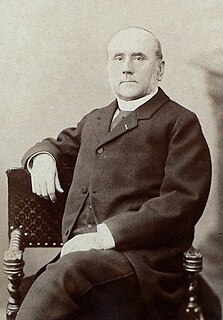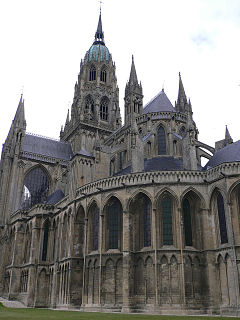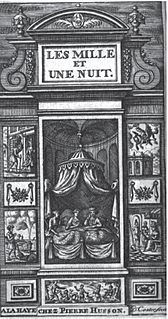
Ambroise Paré was a French barber surgeon who served in that role for kings Henry II, Francis II, Charles IX and Henry III. He is considered one of the fathers of surgery and modern forensic pathology and a pioneer in surgical techniques and battlefield medicine, especially in the treatment of wounds. He was also an anatomist, invented several surgical instruments, and was a member of the Parisian barber surgeon guild.

The Order of Saint Michael is a French dynastic order of chivalry, founded by Louis XI of France on 1 August 1469, in competitive response to the Burgundian Order of the Golden Fleece founded by Philip the Good, duke of Burgundy, Louis' chief competitor for the allegiance of the great houses of France, the Dukes of Orléans, Berry, and Brittany. As a chivalric order, its goal was to confirm the loyalty of its knights to the king. Originally, there were a limited number of knights, at first thirty-one, then increased to thirty-six including the king. An office of Provost was established in 1476. The Order of St Michael was the highest Order in France until it was superseded by the Order of the Holy Spirit.

Ernest Henri Besnier was a French dermatologist and medical director of the Hôpital Saint-Louis in Paris. He was a native of Honfleur, département Calvados.

The Roman Catholic Diocese of Bayeux and Lisieux is a diocese of the Roman Catholic Church in France. The diocese is coextensive with the Department of Calvados and is a suffragan to the Archdiocese of Rouen, which is also in Normandy.

Jean-Louis-Marc Alibert was a French dermatologist born in Villefranche-de-Rouergue, Aveyron. He was a pioneer of dermatology.

Antoine Louis was an 18th-century French surgeon and physiologist.

The French Defence Central Health Service is responsible for medical and sanitary support of the French military and of all institutions placed under the authority of the French Ministry of Defence. It is a joint service, and its central administration is under the direct control of the Chief of the defence staff.

Jean Lemoine, Jean Le Moine, Johannes Monachus was a French canon lawyer, Cardinal, bishop of Arras and papal legate. He served Boniface VIII as representative to Philip IV of France, and founded the Collège du Cardinal Lemoine, in Paris. He is the first canon lawyer to formulate the legal principle of the presumption of innocence.

Anselm Franz, 2nd Prince of Thurn and Taxis, full German name: Anselm Franz Fürst von Thurn und Taxis was the second Prince of Thurn and Taxis, Postmaster General of the Imperial Reichspost, and Head of the House of Thurn and Taxis from 21 February 1714 until his death on 8 November 1739.
Nicolas Heurteloup was a French military physician and surgeon. He was born on 26 November 1750 in Tours and died in Paris on 27 March 1812. He succeeded Pierre-François Percy (1754–1825) as chief surgeon of the Grande Armée, and had himself as his successor Dominique-Jean Larrey (1766–1842). He was the father of physician Charles Louis Stanislas Heurteloup (1793–1864).

Antoine d'Aquin born in 1629 in Paris and died on 17 May 1696 in Vichy was a French physician. In April 1672, he became the king's first doctor in the service of Louis XIV. He was Lord and Count de Jouy-en-Josas.

Les mille et une nuits, contes arabes traduits en français, published in 12 volumes between 1704 and 1717, was the first European version of The Thousand and One Nights tales.
Jean-Joseph Sue or Jean-Joseph Sue (son) was a French physician and surgeon during the Napoleonic Era. He was the father of Eugène Sue.

Sauveur François Morand was a French surgeon.
Alexandre Chaponnier called Polyanthe was a 19th-century French physician, painter, engraver, and playwright.

Nicolas de Blégny was a French essayist, historian and barber surgeon. He was appointed surgeon of Queen Maria Theresa of Spain in 1678, then physician of Kking Louis XIV in 1682.
Germain Célestin Édouard Fournié was a French surgeon, physician, anatomist and physiologist, and a prominent specialist in the field of the voice and speech physiology, as well as fields of neuroanatomy and neurophysiology. He was born in Limoux on 4 March 1833 in the house of his maternal grandfather, Louis Joly. His father, Jean François Fournié, who was a doctor of medicine, served at the time as an Inspector of the mineral waters of Alet-les-Bains. His mother, Marie Célestine Joly, was from a rich and notable family.

Abraham Peyrenc de Moras was a French banker. Though descended from commoners and often described as the son of a barber, his family began its ascent in the 17th century since his grandfather was a hat merchant and his father a licensed surgeon, tax collector and a bourgeois of the city. Abraham surpassed them and experienced a meteoric social ascent in 18th century Paris, cemented by his being made noble in 1720.
Pierre Tolet or Petrus Toletus was a French physician who, together with Jean Canappe contributed to the transmission of medical and surgical knowledge in French.
Jean Canappe was a French physician who was attached to Francis I of France in 1542. He sometimes wrote under the pseudonym Philiatros and was known because he contributed to the transmission of medical and surgical knowledge in French with Pierre Tolet.














